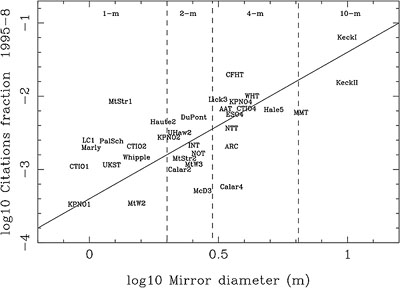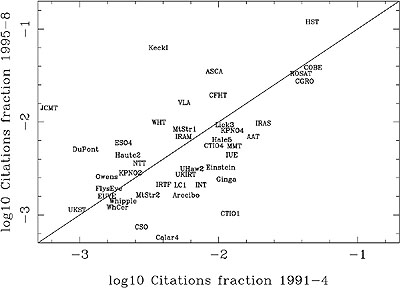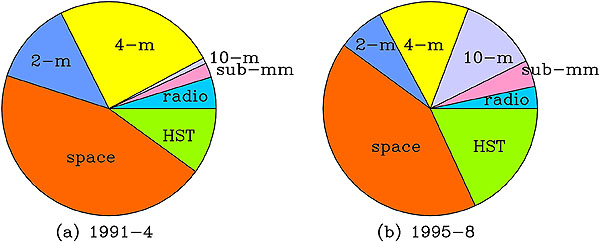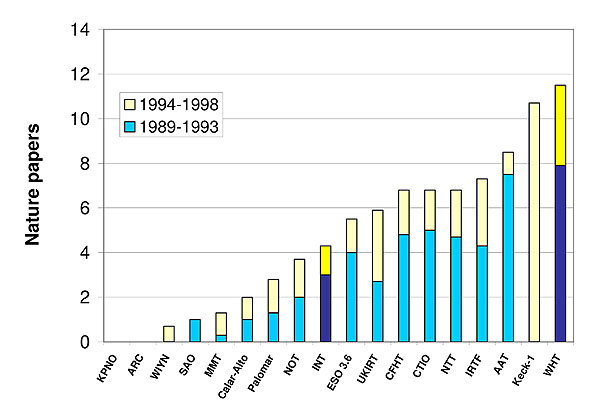- Abt, H. A., 1980, PASP, 92, 249. Citation in text | ADS
- Benn C. R., Sánchez S. F., 2001, PASP, in press. Available at astro-ph/0010304. Citation in text | LANL
- Mayor, M., Queloz, D., 1995, Nature, 378, 355. Citation in text | ADS
- Nature , 2000, 408, 12. Citation in text
| THE ING NEWSLETTER | No. 4, March 2001 |
|
|
THE ING WIDE FIELD IMAGING SURVEY | SCIENCE |
|
|
|
| Previous: | High Redshift Quasars in the ING Wide Field Survey | Up: | Table of Contents | Next: | Normal and Eccentric Dying Suns |
Other available formats: PDF | gzipped Postscript
Scientific Impact of Large Telescopes
Chris Benn and Sebastián Sánchez (ING)
Some telescopes clearly have higher scientific impact than others, but there have been few attempts to quantify this, or to compare impact with cost. Are 4-m telescopes a better investment than 2-m telescopes? Are space telescopes as cost-effective as ground-based telescopes? Recently, we obtained, from the Institute of Scientific Information (ISI), Philadelphia, a list of the 1000 most-cited astronomy papers published worldwide during 1991–8 (the top 125 papers each year). Although high citation isn't an infallible guide to scientific impact, and citation counts are subject to a number of biases (e.g. UK/US astronomers tend not to cite foreign-language publications), most of the hottest new science of the last decade will be represented in this sample of papers. We determined which telescopes were used to obtain the data on which each of these papers was based, and thus measured the impact (fraction of total citations generated) of each telescope averaged over 1991–4 and 1995–8.
The impacts of ground-based optical
telescopes are shown as a function of mirror diameter in Figure
1, and the 1991–4 and 1995–8 impacts are compared in Figure
2. Amongst 4-m class telescopes, CFHT has the highest impact, with
the WHT in second place, but the differences between individual telescopes
are small. Keck I, in use since 1993, has an impact 8 times larger than
that of typical 4-m telescopes, and this factor is similar to the ratio
of collecting areas. No papers from other 8-m–10-m telescopes (apart from
Keck II, commissioned 1996) appear in the list, since most were commissioned
after 1998. The mean impact of 2-m class telescopes is a factor ~4 lower
than that of 4-m telescopes, again consistent with the ratio of collecting
areas. Comparison of individual 2-m telescopes is difficult because the
numbers of papers involved are small.
 |
 |
| Figure 1 (left). Citations fraction 1995–8 vs telescope diameter, for ground-based optical telescopes. Most of these telescopes were in use throughout 1991–8. The straight line indicates citation fraction = 0.6%×(diameter/4 m)2. Statistical errors (Npapers )-0.5 are ~0.2 in log10 for typical 4-m telescopes, ~0.3 for 2-m. In this figure, and Figure 2, a few points have been displaced slightly to avoid overlap of labels. Digits suffixed to the abbreviations distinguish telescopes of different size at the same observatory. [ JPEG | TIFF ]. Figure 2 (right). Citations fraction 1995–8 vs 1991–4, for both ground-based and space telescopes. The straight line has slope 1. Only telescopes with significant impact in both 1991–4 and 1995–8 appear on the plot (e.g. BeppoSAX, Hipparcos, ISO, Keck-II, RXTE, and SOHO all have citation fractions >1% in 1995–8, but zero in 1991–4. [ JPEG | TIFF ] | |
The citation shares of different
types of telescope are compared in Figure 3. 1-m
and 2-m telescopes together contributed half as much science as 4-m telescopes
during 1991–8. Three of the top 40 most-cited papers 1991–8 are based on
data from 1-m telescopes only, including two from the microlensing survey
carried out with the Mt. Stromlo 1.3-m. Extrasolar planets were also discovered
using a small telescope: the Haute Provence 1.9-m (Mayor
& Queloz, 1995, the 9th most-cited paper of that year).
 |
| Figure 3. Citation shares of different types of telescopes, for 1991–4 and 1995–8. '2-m' in this figure includes both 1-m and 2-m class telescopes. [ JPEG | TIFF ] |
The year-2000 capital costs of 2-m, 4-m and 10-m class telescopes are ~$5M, $18M and $80M, while the impacts are in the approximate ratio 1:3:25 (Figure 1). If one assumes that running costs scale roughly as capital cost (Abt, 1980), then the data of Figure 1 indicate that 2-m telescopes are roughly as cost-effective as 4-m telescopes. Keck I is twice as cost-effective, but is the first of its size, and may have a bigger scientific impact than any of the 11 8-m–10-m telescopes now coming online: 4 VLT, 2 Gemini, Subaru, LBT, HET, SALT and GranTeCan.
Notably productive non-optical
telescopes (Figure 2) include JCMT ( ~twice the
impact of a typical 4-m, largely thanks to SCUBA), IRAM and the VLA. The
space telescopes ASCA, BeppoSax, CGRO, COBE, Hipparcos, ROSAT all have
impacts ~4 times higher than a 4-m telescope, but cost ~15–30 times as
much. Comparison of the cost-effectiveness of ground-based and space telescopes
is not straightforward. Some space telescopes (e.g. COBE, Hipparcos) are
launched to solve a specific scientific problem which can't be tackled
from the ground and they may have a short-lived community of citers, so
it's not clear that citation counts are a fair measure of scientific impact.
Others, such as HST, compete more directly with ground-based facilities
(particularly now, with the advent of adaptive optics), and can be used
to tackle similar problems, so a citation-based comparison of cost-effectiveness
is fairer. HST, launched in 1990, generated 15 times as many citations
as a typical 4-m telescope but cost ~100 times as much, ~$2000M (much more,
if the cost of servicing missions is taken into account).
For an independent measure of
scientific impact, we repeated the above analysis using the 452 observational
astronomy papers published in Nature 1989–98, reasoning that only
papers of the highest scientific merit make it into Nature. We found
a close correlation between citation fraction and count of papers in Nature,
except that radio telescopes are over-represented in Nature by a
factor >3 relative to optical telescopes (or, to put it another way, radio
telescopes are under-represented in the citation counts). This discrepancy
highlights the risk of incurring metric-specific biases when comparing
the scientific impacts of different kinds of telescope or community. The
numbers of Nature papers generated by ground-based optical telescopes
during 1989-98 are compared in Figure 4. The WHT
was the most productive ground-based optical telescope during this period.
 |
| Figure 4. Number of Nature papers generated 1989-98 by ground-based optical telescopes with mirror diameter >3.5m (for comparison, figures for the 2.5-m INT and Nordic Optical Telescope are also included). [ JPEG | TIFF ] |
For each of the highest-cited and Nature papers generated by the WHT, we checked the instrumentation used. During most of 1991–8, observers were offered a choice of between 6 and 8 instruments at the WHT. However, 28 of the 31 WHT papers used data obtained with the intermediate-resolution spectrograph ISIS (21) or with an optical imaging camera (7).
The list of the 1000 most-cited
papers can also be used to break down scientific impact by region, subject,
journal or host institution (of first author). 61% of the citations to
the 1000 most-cited papers are to papers with first authors at US institutions,
11% UK, 20% European (non-UK) and 8% other (mainly Australia, Canada, Japan).
52% of the citations are to extragalactic papers, 34%
stellar/galactic, 7% solar-system,
7% technical. At 4-m telescopes whose users are predominantly from North
America or the UK, 75% of the cited papers (and 29 of the 34 Keck papers)
are on extragalactic topics. For European (non-UK) 4-m telescopes, the
fraction is 44%. The shares of the citation count by journal are: ApJ
44%, MNRAS 9%, A&A/S 10%, Nature 11%, others 26%.
The most-cited host institutions in the UK were IoA Cambridge and Durham
(with Durham creeping ahead in 1995–8).
Perhaps our most interesting conclusion is that during 1991–8, the era of 4-m telescopes, a substantial fraction of the science was generated by 1-m and 2-m telescopes (Figure 3). This strong showing by small optical telescopes suggests that cutting-edge science doesn't always require the largest aperture available, and this augurs well for the continued scientific impact of 4-m telescopes in the era of 8-m telescopes.
For further statistics, and full
details of the analysis, see our article in press at PASP (Benn
& Sánchez, 2001). A recent feature article in Nature
(2000) discusses these results further. We thank ING summer students Ed
Hawkins, Samantha Rix and Dan Bramich for their help with this project.
References:
Email contact: Chris Benn (crb@ing.iac.es)
| Previous: | High Redshift Quasars in the ING Wide Field Survey | Up: | Table of Contents | Next: | Normal and Eccentric Dying Suns |
| GENERAL | THE ING WIDE FIELD IMAGING SURVEY | SCIENCE | TELESCOPES AND INSTRUMENTATION | OTHER NEWS FROM ING | TELESCOPE TIME |